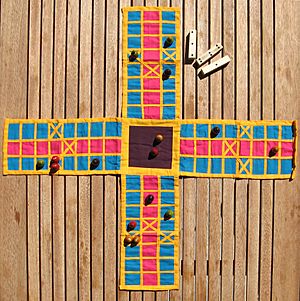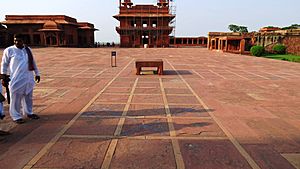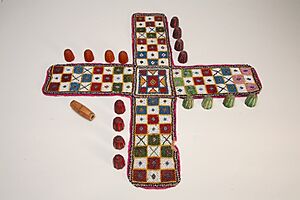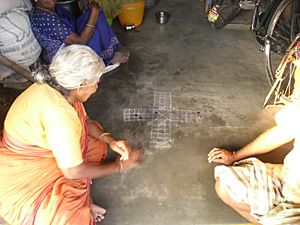Pachisi facts for kids

A game of Pachisi on a cloth board
|
|
| Years active | Ancient India to present |
|---|---|
| Genre(s) | Board game Cross and circle game Race game Mind sport |
| Players | 2–4 |
| Setup time | Negligible |
| Playing time | 30–60 minutes |
| Random chance | Medium (dice rolling) |
| Skill(s) required | Strategy, tactics, counting, probability |
| Synonym(s) | Twenty-Five |
Pachisi is an old board game from Ancient India. It's a type of game called a "cross and circle" game. You might know similar games like Ludo or Parcheesi.
The game is played on a board shaped like a cross. Players move their game pieces around the board. How far you move depends on how you throw special shells called cowrie shells. The name Pachisi comes from the Hindi word paccīs, which means "twenty-five." This is because 25 is the highest score you can get when throwing the cowrie shells.
Pachisi has many different versions around the world. For example, Barjis is played in the Middle East, and Parchís is popular in Spain. In Colombia, it's called Parqués. Many modern games like Sorry! and Ludo are based on Pachisi.
Contents
History of Pachisi
Games similar to Pachisi have been found in India from a very long time ago. Some game pieces and dice from the Iron Age (around 1100-800 BC) have been discovered. Pictures of cross-shaped boards have also been seen in ancient art from around 200 BC.
One famous story tells how the Mughal Emperor Akbar (who ruled India in the 1500s) loved to play Pachisi in a grand way. He had huge game boards built in his palaces, like at Fatehpur Sikri. These boards were so big that the squares were part of the actual court floor! Instead of small game pieces, young people from his palace would act as the pieces. They would move around the giant board based on how Akbar threw the dice. You can still see traces of these huge game courts in places like Agra and Allahabad.

In 1938, an American company called Transogram made a popular version of the game. They first called it "Game of India," and later "Pa-Chiz-Si: The Game of India."
How to Play Pachisi
Pachisi can be played by two, three, or four players. If there are four players, they usually play in two teams. One team might use yellow and black pieces, and the other team uses red and green. The goal is to be the first team to move all your pieces around the board and back to the center.
Game Pieces and Cowrie Shells
Each player usually has four special pieces that look like beehives. These pieces come in different colors, like black, green, red, and yellow.
Instead of dice, players use six cowrie shells to see how many spaces they can move. You throw the shells from your hand. The number of shells that land with their opening facing up tells you how many spaces to move.
| Cowries facing up |
Value | Earns another turn? |
|---|---|---|
| 0 | 25 | Yes |
| 1 | 10 | Yes |
| 2 | 2 | No |
| 3 | 3 | No |
| 4 | 4 | No |
| 5 | 5 | No |
| 6 | 6 | Yes |
The Game Board
The Pachisi board is often made of cloth and has a cross shape. In the very center of the board is a large square called the Charkoni. This is where your pieces start and finish.
Each of the four arms of the cross has three columns of eight squares. Players move their pieces along these columns.
Some squares on the board are special and are called "castle squares." If your piece lands on a castle square, it is safe! Opponents cannot capture your piece while it is on a castle square.
Starting the Game
To decide who goes first, each player throws the cowrie shells. The player with the highest score starts the game. Then, turns go around the board in a counter-clockwise direction.
To get a piece onto the board from the Charkoni, you need to throw a "grace" number. These are usually 6, 10, or 25. If you throw one of these numbers, you can bring one of your pieces onto the first square of your path. You also get to take another turn!
Moving Your Pieces
Once your pieces are on the board, you move them down the middle column of your arm. Then, you go counter-clockwise around the outside columns of the board.
- You can only move one piece with each throw of the cowries.
- More than one of your own pieces can be on the same square.
- If your piece lands on a square (that is not a castle square) where an opponent's piece is, you "capture" or "kill" their piece! Their captured piece must go back to the Charkoni. They can only re-enter the game with a grace throw. When you capture a piece, you usually get an extra turn.
- Your pieces cannot move onto a castle square if an opponent's piece is already there.
Finishing the Game
After your piece travels all the way around the board, it moves back up its own central column. To win, a piece must land exactly on the Charkoni (the center square) with a direct throw.
A common strategy is to keep your returning pieces on the castle squares that are 25 moves away from the Charkoni. This keeps them safe from capture. Then, when you throw a 25, you can move them directly into the center and finish the game! This is why the game is called Pachisi, after the number 25.

See also
 In Spanish: Pachisi para niños
In Spanish: Pachisi para niños
- Ashte kashte—a game with similar rules
- Chaupur
- Patolli
- Parqués
- Mensch ärgere Dich nicht
- Ludo


